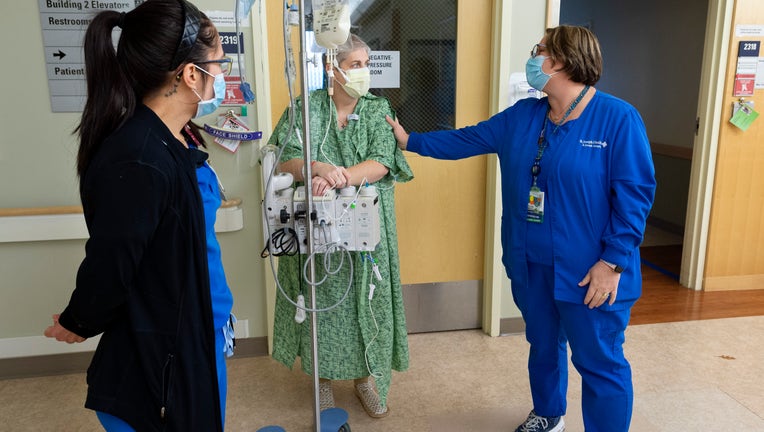New study highlights differences in health care access among essential workers

Alanna Bretzmann, RN, a patient and Nurse Manager Kobie Walsh, RN, from left, talk before an afternoon walk for exercise in the halls at St. Joseph Hospital in Orange, CA on Thursday, March 4, 2021. (Photo by Paul Bersebach/MediaNews Group/Orange Cou
A recently released study revealed that not all essential workers are receiving the same amount of health care.
Public Health Reports published findings from the National Institute for Occupational Safety and Health in March, examining the critical need for health care for essential workers in order for them to remain healthy during the pandemic.
The study examined 2017-2018 data from the Behavioral Risk Factor Surveillance System to see how prevalent health care is among 208 adults between 18 and 64 years old in 31 states.
RELATED: MLB to distribute $1.5 million in free tickets to essential workers
Results revealed that certain essential workers had less access to health care compared to their counterparts looking at four key areas: having health insurance, being able to afford to see a doctor when needed, having a personal health care provider and having a routine checkup in the previous year.
The results revealed that 46% of workers in farming, fishing and forestry occupations were most likely not to have health insurance. Twenty-nine percent of personal care aides were most likely to have been unable to see a doctor when needed because of cost. Fifty-one percent of construction laborers were most likely to lack a personal health care provider and nearly half of laborers didn’t have a routine physical checkup in the past year. Workers in three broad occupation groups— food preparation and serving, building and grounds cleaning and maintenance and construction trades had significantly lower levels of health care access for all four measures, compared with workers in general.
RELATED: Chicago opens vaccination site for union workers
Researchers said the study is important because essential workers are at higher risk of contracting COVID-19 because they must report to work and can’t always adhere to the COVID-19 safety protocols. They concluded that lack of health insurance and underinsurance were common among different essential workers, making it difficult for them to get medical help should they contract an infectious disease.
"This study used data from before the start of the COVID-19 pandemic, so it provides a baseline to understand what kind of health care access was in place for essential workers," Winifred L. Boal, MPH, research epidemiologist and lead author of the study, said. "Improving access to health care for all workers, including essential workers, is critical to ensure workers’ health and workforce stability."
This story was reported from Los Angeles.


